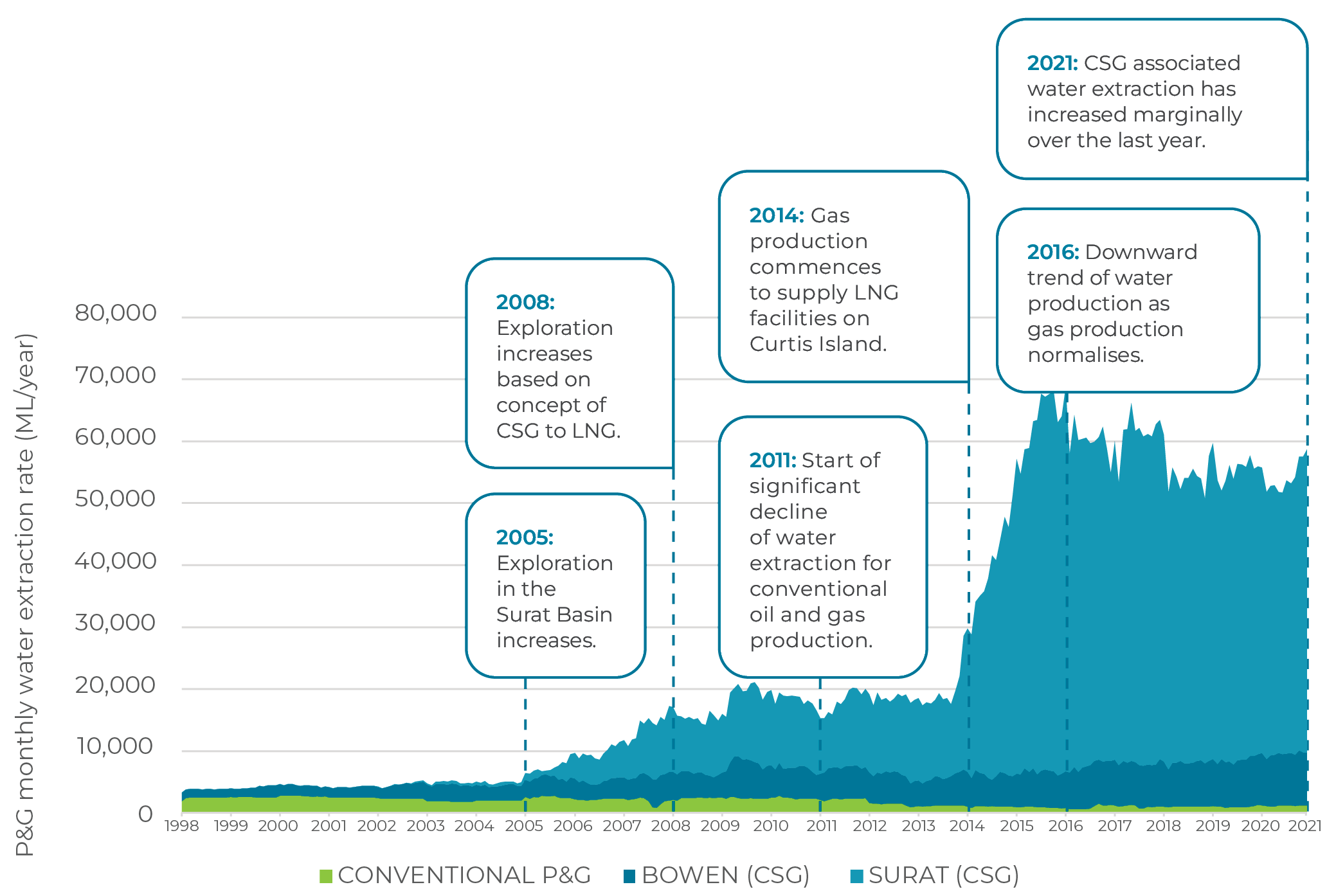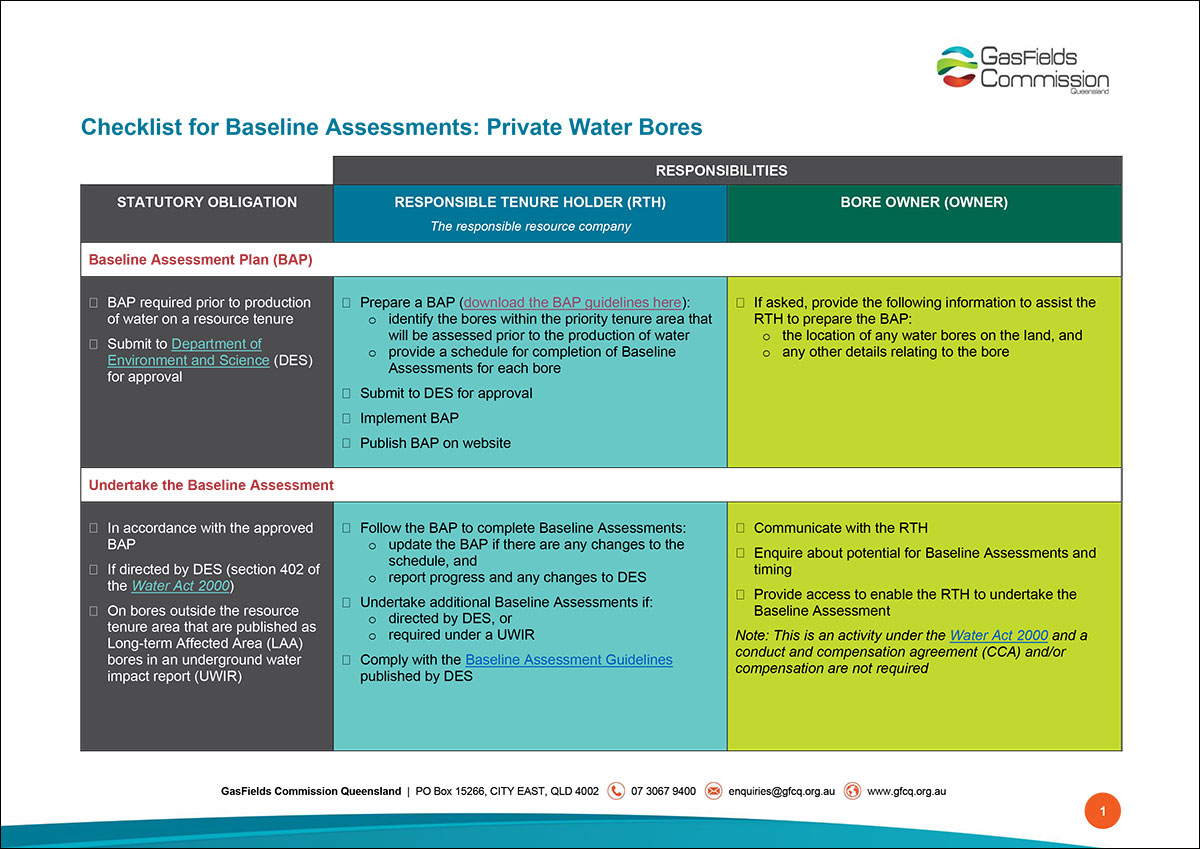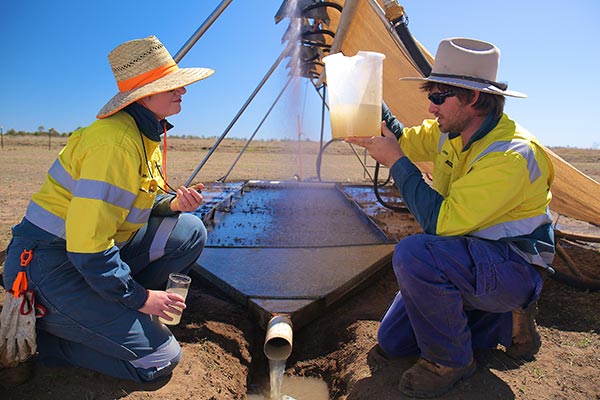Water
Water is one of the most important substances on earth – with groundwater playing a critical role in Australia’s water needs and requiring careful, sustainable, and responsible management.
Groundwater is a critical resource for various sectors across Queensland particularly for agricultural and domestic uses. A proportion of groundwater is extracted during the production of coal seam gas (CSG) to lower pressure in coal seams thereby allowing gas to flow up the gas wells to the surface.
Historical associated water extraction by the P&G tenure holders in the Surat CMA

Data source: see Shared Landscapes – Industry Trends (Chapter 2 – Infrastructure and Activities)
CSG Produced Water
The groundwater that is removed from coal seams in order to produce CSG is known by several different names, including CSG produced water, co-produced water, associated water and CSG water (for consistency the Commission will be using the term ‘CSG produced water’ throughout this site). This water can be treated and used beneficially for a range of purposes.
The Petroleum and Gas (Production and Safety) Act 2004 defines ‘produced water’ as “CSG water; or associated water for a petroleum tenure. In the act, reference to produced water includes – treated and untreated CSG water, and concentrated saline water produced during the treatment of CSG water”.
Groundwater extracted from the coal seams can vary significantly in its composition and degrees of salinity, which can range from 300 to 10,000 milligrams per litre (mg/L).
During the early stages of CSG extraction, typically larger volumes of groundwater is extracted to depressurise the coal seams. The volume decreases exponentially over time. Depressurisation coal seams can cause water level declines in the aquifer and impact nearby water bores extracting from the same aquifer (see below: Groundwater Take – Management of Potential Impacts).
In Queensland, CSG produced water is used for crop irrigation, livestock watering, industrial manufacturing, dust suppression and for the construction of onsite gas field infrastructure. CSG produced water is also reinjected into groundwater aquifers for future use. The treatment and reuse of CSG produced water is strictly regulated.
Resource companies have the right to take ‘associated water’ (CSG produced water) under Part 4 of the Petroleum and Gas (Production and Safety) Act 2004 and Part 6D, Division 5, Subdivision 2 of the Petroleum Act 1923 – as water is a by-product in the process of extracting gas.
In addition, resource companies have an obligation to comply with the underground water management framework under Chapter 3 of the Water Act 2000.
![]() For more information on the types, uses and regulation of CSG produced water in Queensland, visit the Department of Environment and Science website: www.environment.des.qld.gov.au.
For more information on the types, uses and regulation of CSG produced water in Queensland, visit the Department of Environment and Science website: www.environment.des.qld.gov.au.
Regulation
Other legislation that may control the use of CSG produced water, depending upon how it is to be managed and used, include:
- The Waste Reduction Recycling Act 2011 recognises that CSG produced water, which is a ‘waste’ under the Environmental Protection Act 1994, may have beneficial uses. This Act prescribes the process whereby CSG produced water can be reclassified as a resource and used for a beneficial purpose.
- The Water Supply (Safety and Reliability) Act 2008 outlines how operators undertake a water supply service such as supplying treated CSG produced water for the purposes of a municipal drinking water supply.
- The Environmental Protection Act 1994 imposes requirements on the management of CSG produced water, including its use, treatment, storage and disposal.
- The Coal Seam Gas Water Management Policy 2012 encourages resource companies to manage CSG produced water in a way that benefits regional communities and reduces impacts on the environment.
Beneficial Use
A large portion of CSG produced water is treated and beneficially used for a variety of applications including irrigation, town water, industrial uses or reinjection into aquifers. For more detail, download GISERA’s Aquifer managed recharge using CSG produced water report.
Until recently, the beneficial use of CSG produced water needed to be approved by the Queensland Government under a ‘Beneficial Use Approval’. While some of these approvals are still in effect until they expire, recent legislative changes have introduced ‘End of Waste’ approvals and codes that allow for CSG produced water to be used for beneficial purposes.
The main drive for this change was to reduce the regulatory burden on a by-product (e.g. CSG produced water) that fits the criteria to be deemed a ‘resource’ instead of a ‘waste’. For CSG produced water to be deemed a resource, trials must be conducted to demonstrate it meets a set of requirements. If the CSG produced water meets these requirements and is deemed a resource, further regulatory approvals for its use would not be required.
![]() For more information on the End of waste (EOW) framework, visit the Department of Environment and Science website: www.environment.des.qld.gov.au.
For more information on the End of waste (EOW) framework, visit the Department of Environment and Science website: www.environment.des.qld.gov.au.
Groundwater Take: Management of Potential Impacts
When water is extracted from a coal formation, depressurisation can cause water level declines in the aquifer and impact nearby water bores that are extracting from the same aquifer.
In areas where higher connectivity exists between a coal formation and surrounding aquifers, water supply bores within the vicinity of the petroleum and gas production area may also be affected. This will depend on the degree of hydraulic connectivity between a target coal formation and the overlying or underlying aquifers.
Free gas (mainly methane) can also potentially impact nearby water bores by adversely affecting the quantity or quality of water provided. This may cause damage to the bore infrastructure or create a health or safety risk.
This can occur if a portion of the gas released by depressurisation of coal moves under buoyancy effects into a nearby bore. Methane is not considered toxic, but it is an asphyxiant at a concentration of over 50% (500,000 ppm) in air.
![]() Download CSIRO Fact Sheet ‘Methane seeps in the Condamine River’ to learn about the current state of scientific knowledge on methane seeps in the Condamine River.
Download CSIRO Fact Sheet ‘Methane seeps in the Condamine River’ to learn about the current state of scientific knowledge on methane seeps in the Condamine River.
Any authorised water bores impacted, or likely to become impacted by that extraction process may be eligible for a Make Good Agreement (MGA). For more information see: Underground Water Impact Reports.
![]() If a bore owner is concerned their water bore may have been impaired by gas development they should check the predictions of impacts for that bore via the Office of Groundwater Impact Assessment’s bore search tool or contact the Department of Resources’ Resource Community Infoline for assistance:
If a bore owner is concerned their water bore may have been impaired by gas development they should check the predictions of impacts for that bore via the Office of Groundwater Impact Assessment’s bore search tool or contact the Department of Resources’ Resource Community Infoline for assistance:
- Make an enquiry or complaint online
- Email: resources.info@resources.qld.gov.au
- Phone: 137 107
The impacts of the extraction of CSG produced water on groundwater supplies are managed under the Water Act 2000 (the Water Act). Resource companies have an obligation to comply with the groundwater water management framework under the Water Act. Chapter 3 of the Water Act requires that:
- petroleum and gas operators monitor and assess the impact of their operations on underground water;
- operators publish a report which outlines their obligations, including monitoring obligations on aquifers and springs;
- operators comply with legally binding make good agreement obligations, including the requirement to undertake a bore assessment and negotiate a make good agreement; and
- the independent Office of Groundwater Impact Assessment (OGIA) assess and predicts the impact of CSG water extraction on groundwater resources in cumulative management areas (CMAs).
With a growing number of users accessing groundwater and the various activities that could potentially impact upon it, it is important to consistently and effectively manage and monitor the condition, function and use of this precious resource.
![]() This Office of Groundwater Impact Assessment video explains how groundwater impacts may occur in aquifers surrounding CSG formations in the Surat Basin.
This Office of Groundwater Impact Assessment video explains how groundwater impacts may occur in aquifers surrounding CSG formations in the Surat Basin.
Groundwater Management Framework
The Groundwater Management Framework requires tenure holders to:
- Carry out a baseline assessment of landholder water bores near planned wells before any water extraction can commence.
- Submit a baseline assessment plan (BAP) to the Department of Environment and Science (DES) for approval before any water extraction commences.
- Prepare an Underground Water Impact Report (UWIR) every three years which includes an assessment of the water pressure reductions in aquifers and impacts to springs in the long and short-term. The UWIR must identify environmental values that could be impacted through the exercise of underground water rights as well as any landholder bores and /or springs that are predicted to be affected by the existing and forecast associated water take.
- Carry out a detailed bore assessment of each water bore identified in the UWIR and enter into an agreement with the bore owner about the outcome and measures to make good if the capacity of the bore is or is likely to be impaired.
The same regulatory framework operates across Queensland, however in areas of intense development where multiple projects are involved, a Cumulative Management Area (CMA) is declared by DES.
Under those circumstances a water level decline in a water bore may be due to two or more individual projects or industries making make good responsibilities unclear. Also, the construction of models by the individual tenure holders to assess future impact becomes difficult as data would be needed from adjacent projects.
Similar issues would arise for the development of monitoring networks. In this instance the independent Office of Groundwater Impact Assessment (OGIA) is responsible for preparing the UWIR for the CMA.
The Surat CMA UWIR prepared by OGIA is the most significant UWIR as the Surat CMA is an area of intense CSG development. Outside that area, UWIRs prepared by individual resource tenure holders, and are approved by DES.
![]() Download the approved Underground Water Impact Reports.
Download the approved Underground Water Impact Reports.
If a bore impairment was not predicted in an approved UWIR, DOR may forward their investigation findings to DES. Under section 418 of the Water Act 2000, if DES reasonably believes a water bore:
- can no longer supply a reasonable quantity or quality of water for its authorised use or purpose; or
- is affected or is likely to be affected in the future by the resource company extraction; or
- has an impaired capacity
the department can then require the resource company to carry out a bore assessment and enter into a make good agreement.
Baseline Assessment
Before any gas development occurs, a baseline assessment must be undertaken by the resource company. Baseline assessments measure the performance of authorised bores in the area and provide a reference point for subsequent bore assessments.
![]() For more information on each party’s responsibilities when completing a Baseline Assessment, download the Commission’s ‘Checklist for Baseline Assessments‘.
For more information on each party’s responsibilities when completing a Baseline Assessment, download the Commission’s ‘Checklist for Baseline Assessments‘.
Make Good Agreement
Process
The make good agreement process involves landholders and resource companies undertaking bore assessments to determine if make good measures are required.
Bore
Assessments
Bore assessments are undertaken to assess the capacity of a water bore and to establish whether or not the bore has, or is likely to have, an impaired capacity due to resource activity.
Underground Water Impact Reports
An underground water impact report identifies bores in a long-term affected area that are predicted at any time in the future to exceed a specified bore trigger threshold.
Make Good Agreement
Templates
The GasFields Commission has developed a suite of make good agreement templates to be used by bore owners and industry as a starting point for negotiations.
Groundwater
Monitoring
Across the gas producing regions of Queensland there are currently four extensive groundwater monitoring networks that serve a variety of functions.
Groundwater
Research
Continuous research and understanding of Queensland’s groundwater systems ensures its proper management and sustainable use by all those who rely on them.



